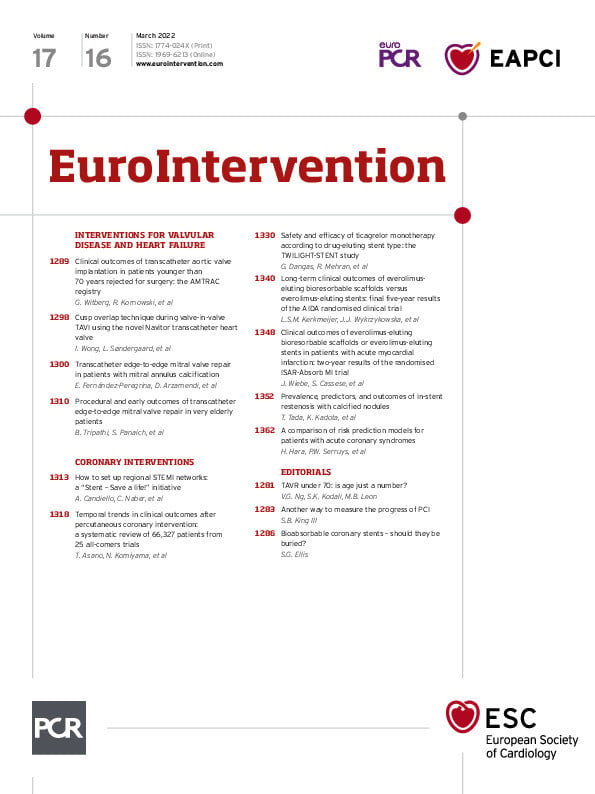In this edition of the Journal, Kerkmeijer, Wykrzykowska and colleagues report the final outcome of the AIDA trial1.
The authors should be congratulated on pursuing and completing 5-year follow-up in an area of cardiology that some interventionalists have given up for dead. This 1,845-patient randomised clinical trial (RCT) compared ABSORB, Abbott’s fully bioabsorbable poly l-lactic acid-based 157 µm strut thickness bioresorbable vascular scaffold, with their 81 µm metallic XIENCE EES. With target vessel failure as the primary outcome measure, there was no difference in the primary outcome at 5 years (17.7% with ABSORB, 16.1% with XIENCE). However, the device thrombosis previously reported from this and other trials remained significantly higher with ABSORB at 5 years (4.8% vs 1.5%, respectively), although that risk appeared to level off around years 3-4 when the device had resorbed. These findings are similar to those from other RCTs, which led to limited device use and to the company removing ABSORB from the marketplace in 20172.
The original concept behind bioresorbable stents (BRS) was that they would eliminate: 1) the jailing of a segment of coronary artery which eliminated normal vasomotor responses and 2) metal and permanent polymer engendered chronic inflammation and refractory restenosis.
While contemporary stents have improved and refractory restenosis is less common, it is still a problem for a small percentage of patients treated today. Our institutional longitudinal percutaneous coronary intervention (PCI) database finds the 10-year risk of 1st, 2nd, 3rd and 4th revascularisations after initial single site stenting to be 27.7%, 7.3%, 2.3% and 1.6%, respectively, with about half of these due to restenosis. The near uniform use of intravascular ultrasound (IVUS) or optical coherence tomography (OCT), which began about 2-3 years ago in our cath lab, is not reflected in these results, and likely would reduce events rates by a relative 30-40%3. Once restenosis has become recurrent, treatment options become somewhat limited: bypass surgery, more medicines, brachytherapy, or drug-coated balloon (DCB) PCI. The cardiology community needs an RCT comparing the latter two, but our same registry finds for brachytherapy (typically applied for the 2nd restenosis at the target site) an 18% target lesion failure rate at 1 year, rising to 40-50% at 3 years, which is not dissimilar to results published from other centres45. DCB results appear, in general, to be similar6. The risk of recurrent restenosis for any given patient is low, but most interventionalists have seen patients with restenosis and 10-15 stents, and ask, “what’s next?” For many patients, we don’t have a good solution.
What might it take for interventionalists to want to have a BRS back on the cath lab shelves as a treatment option? Some patients and physicians might like the absence of substantial metal in their coronary arteries, as long as restenosis, device thrombosis, device delivery and cost weren’t compromised. Others would want an advantage in one or more of these, without a major downside. It is unfortunate that we can’t predict well who is very likely to restenose and target them in particular. For example, in our database the 2-year risk of target lesion revascularisation in high-risk patients undergoing first stenting (e.g., diabetics with lesions with reference vessel diameter <2.5 mm, requiring stents >30 mm in length) is 27.8%, whereas for de novo lesions without any of the aforementioned risk factors it was 9.7% (and, of course, current BRS tend not to do as well in smaller arteries). Excluded from this “calculus” are parameters such as the cross-sectional area from IVUS or OCT images, as neither device is routinely used in most labs.
An interesting potential role for BRS is for treatment of a 1st time restenosis, in order to minimise the risk of multi-layer in-stent restenosis. Several groups have reported small series using this approach, with 12-month revascularisation rates ranging from 10-33%78.
It’s also interesting to speculate, given the clear-cut improved results of metallic drug-eluting stents with intravascular imaging3, what the AIDA and ABSORB study results might have been if IVUS or OCT use had been commonplace (presumably intraluminal scaffold dismantling 9 and its consequences would have been lessened).
While a full review of the current status of BRS in this space is not possible, it should be noted that Abbott has moved on to a 99 µm strut thickness device, for which they have almost finished enrolment in their LIFE-BTK below-the-knee study. Other companies, such as Biotronik, which appears to be furthest along, have continued to evolve their product (DREAMS 3G has 99-147 µm strut thickness, depending on stent diameter, and is now being evaluated in the BIOMAG-1 study) for coronary use. A recent review listed 11 companies, mostly from Asia, still active in clinical trials with BRS10. That said, other companies in this space have gone bankrupt.
In summary, this report1 and the upcoming 5-year report from the ABSORB IV trial will close the door on this chapter on the clinical use of fully bioabsorbable stents, but we must await the results of ongoing and planned trials of future generation devices to know if the field is merely slumbering and might reawaken soon.
Conflict of interest statement
The author has no conflicts of interest to declare.
Supplementary data
To read the full content of this article, please download the PDF.

